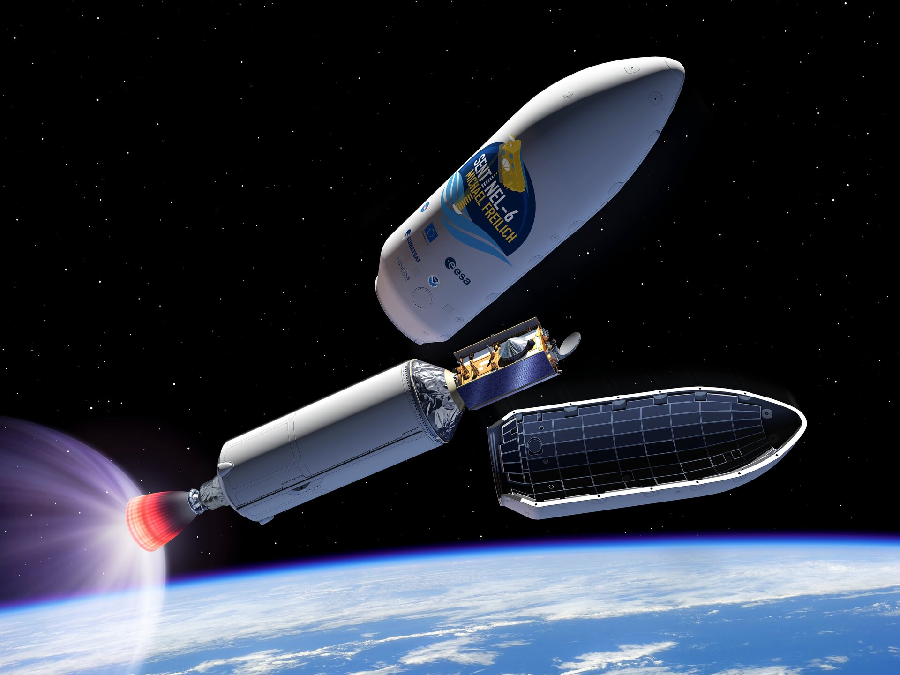Featured Image Source: European Space Agency / P. Carril
Over the weekend, SpaceX will launch NASA's house-shaped Sentinel-6 Michael Freilich satellite. It is a joint project between NASA and the European Space Agency (ESA). The new satellite is named after former NASA Earth Science Division Director Michael Freilich, who worked for over a decade at the agency. The Sentinel-6 satellite is designed to capture the most detailed measurements of sea-surface height which will help provide meteorologists' with enhanced weather and hurricane intensity forecasts, as well as aid in the creation of climate models. During a press conference today, ESA Mission Scientist Craig Donlon talked about why the Sentinel-6 satellite looks like a tiny house. "Many people ask about the shape of this spacecraft, our little house in space. Sentinel-6 has a design heritage in the ESA CryoSat satellite. [...] That makes for a very stable satellite design which is really important for a satellite altimeter mission," he said.
LIVE: Learn about the science of the Sentinel-6
— NASA (@NASA) November 20, 2020
Michael Freilich satellite, set to collect the most accurate data yet on sea levels, with experts from @NASAEarth, @NASAJPL,@NOAA, @ESA, @UW & @EUMETSAT. Ask Q's with #SeeingTheSeas: https://t.co/nxqVbp3fyF https://t.co/nxqVbp3fyF
The golden house-shaped satellite will be launched to space atop a SpaceX Falcon 9 rocket, scheduled to liftoff on November 21 at 12:17 p.m. EST from Space Launch Complex-4 at the Vandenberg Air Force Base in California. The United States Space Force 30th Space Wing weather squadron forecasts 80% “GO” launch conditions for Saturday. Their primary weather concern is ground winds of 20 knots during the launch window. If the mission is delayed, the agency said --"backup launch opportunities are available on subsequent days, with the instantaneous launch window falling about 12 minutes earlier each day."
The Sentinel-6 Michael Freilich launch from @30thSpaceWing is targeted for tomorrow, Nov. 21 at 12:17pm ET! Join us today for prelaunch activities:
— NASA's Kennedy Space Center (@NASAKennedy) November 20, 2020
🌎 3:30pm ET: Science Briefing
🌊 5pm ET: Prelaunch News Conference
🛰️ 7:30pm ET: NASA Edge Show
📺: https://t.co/1XQVljTkIl pic.twitter.com/FQV6mm3tAC
During the Sentinel-6 mission, SpaceX will attempt to recover the Falcon 9's first-stage booster. "A little more than two minutes after the Falcon 9 rocket lifts off, the main engine will cut off. Shortly after, the rocket's first and second stages will separate, followed by second-stage engine start. The reusable Falcon 9 first stage will then begin its automated boost-back burn to the launch site for a propulsive landing. The first cutoff of the second stage engine will take place approximately eight minutes after liftoff," NASA said in a press release. The booster will land on solid ground at the Vandenberg Air Force Base, as the rocket's upper-stage remains in orbit. The agency shared the mission's timeline stating-- "It will fire a second time 45 minutes later, at which point the launch vehicle and the spacecraft will be in a temporary 'parking' orbit. Several minutes later, the launch vehicle and the spacecraft will separate. The satellite will begin solar panel deployment about one hour and seven minutes post-launch and is expected to make first contact about 25 minutes after that." SpaceX's Falcon 9 upper stage will deploy Sentinel-6 into low Earth orbit at an altitude of around 1,336 kilometers (830 miles). NASA will broadcast the mission starting at 11:45 a.m. EST on Saturday. You can watch SpaceX deploy the golden house-shaped satellite Live in the video below.
WATCH IT LIVE!








